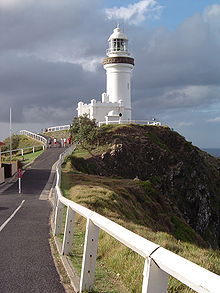Cape Byron Light
The Cape Byron Light is an active lighthouse near Cape Byron in New South Wales , Australia . The lighthouse is located at the easternmost point of mainland Australia, around three kilometers northeast of the city of Byron Bay and the tower is the brightest lighthouse in Australia with 2,200,000 cd .
history
The tower was built in the style of James Barnet by Charles Assinder Harding, who also built the Norah Head Light and Point Perpendicular Light . Construction began in 1899 and cost £ 10,042, £ 8,000 for the equipment and lantern and £ 2,600 for the road from the town of Byron Bay .
The construction was completed with a celebration on November 30, 1901 and a large banquet, to which a special train brought visitors from Lismore and Murwillumbah , including Prime Minister John Lake of New South Wales, who traveled from Sydney on the steamer Victoria . However, the ship did not arrive until the following day due to bad weather. That is why the opening took place one day later, on December 1, 1901.
Light, light generation and light intensity
The Fresnel lens in use today is the first built in that Henry-LePaute made. The diameter of the lens is 2 meters; it contains 760 prismatic cut glasses. The original light was produced by six kerosene wick lamps that together produced 145,000 cd. When they were replaced in 1922, the new kerosene burner reached 500,000 cd. In 1956 the system was electrified and the timing mechanism was replaced by an electric motor. A 1000 watt halogen lamp has been in use since then. The total light intensity was increased to 2,200,000 cd.
The lighthouse glows white at short intervals, and continuously red in the northeast, to the Julian Rocks and over the nearby reefs.
Appearance and tourist information
The lighthouse was built from individual stone blocks and painted white. The building blocks were knocked out of the building ground and mixed with cement, then plastered both inside and outside. This technology ensured that the structure was very strong. The lighthouse is on Lighthouse Road, east of Bayron Bay. The lighthouse and the road are open daily, parking is available. Guided tours take place on Tuesdays and Thursdays throughout the year. In summer, reservations on Saturdays are desirable.
Next to the tower is a lighthouse keeper's house, which is also white and the base is painted blue. There are also two houses for the lighthouse keeper's assistants, where tourists can stay overnight.
Since this lighthouse is very famous, more than 500,000 people visit it every year. In the Bay whale watching (are whale watching ) possible. The Whale Research Center of Southern Cross University is located there .
Responsibilities
The light production is overseen by the Australian Maritime Safety Authority and the building is managed by the Department of Environment, Climate Change and Water as part of the Cape Byron State Conservation Area and the Byron Bay Headland Reserve Trust .
See also
Web links
- The Cape Byron Lighthouse ( English ) In: New South Wales Lighthouses . Lighthouses of Australia Inc. August 4, 2003. Retrieved February 5, 2011.
- Information on byron-bay-beaches.com
Individual evidence
- ↑ Alan Clark, South Coast Register: Newspaper Article Marks Point Perpendicular 100th Archived from the original on March 10, 2011. Information: The archive link was automatically inserted and not yet checked. Please check the original and archive link according to the instructions and then remove this notice. In: Lighthouses of Australia Inc Bulletin . June 1999.
- ↑ a b c d Information on byron-Bay.com . Retrieved September 12, 2010
Coordinates: 28 ° 38 ′ 20.1 ″ S , 153 ° 38 ′ 10.3 ″ E
